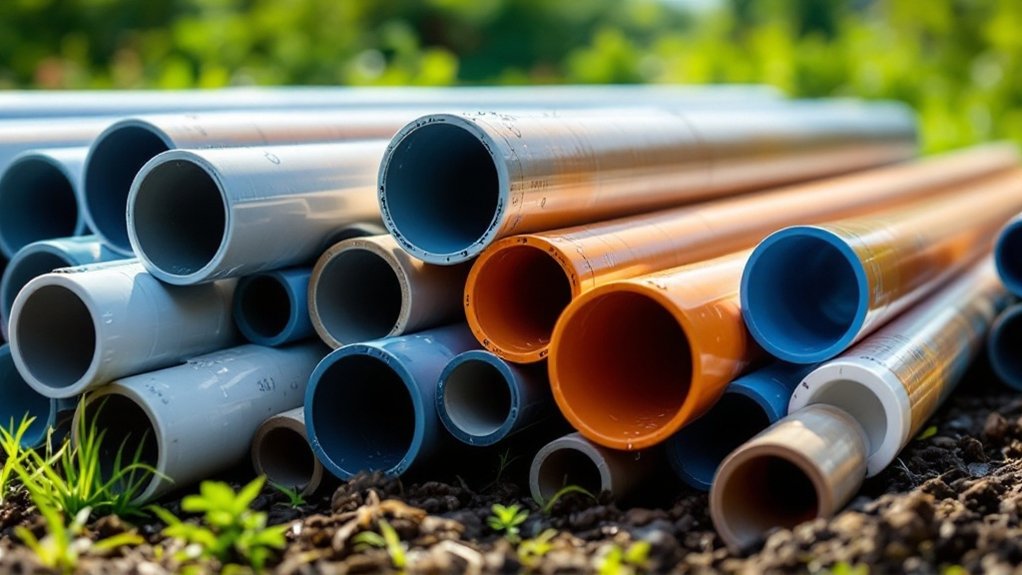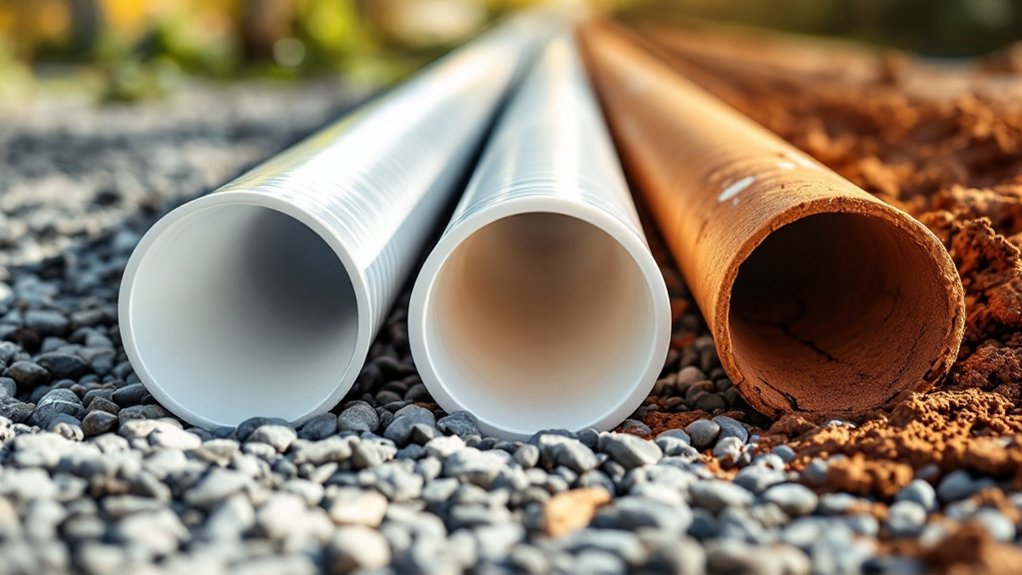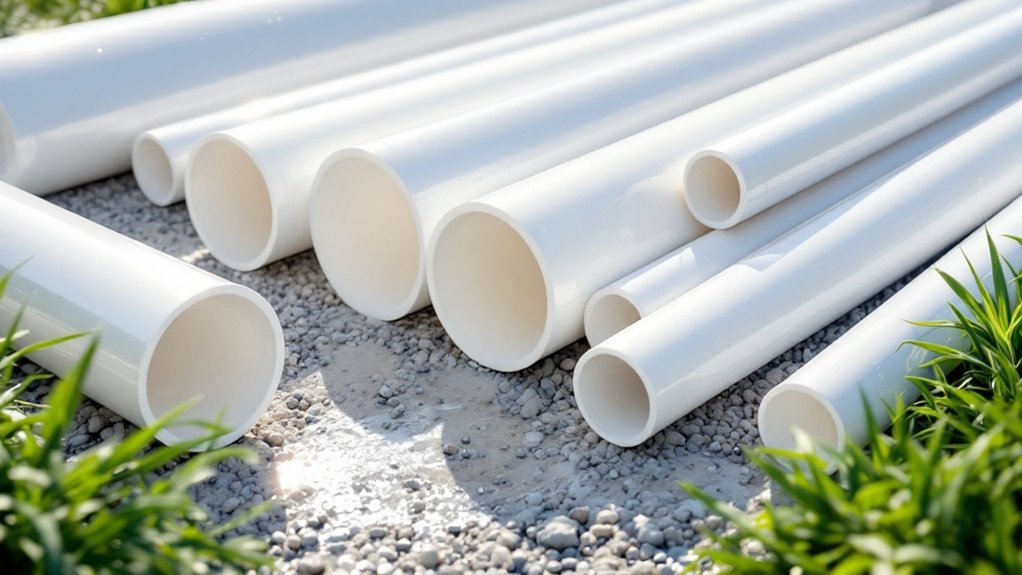For stormwater drainage, use Schedule 40 PVC pipe in high-traffic areas like driveways due to its superior crush resistance. Choose SDR35 for underground applications where soil movement occurs, as it offers flexibility without cracking. Perforated PVC works well for catch basins, while solid PVC guarantees leak-free transfer. Select 2-4 inch diameters for residential projects and maintain a minimum 1-2% slope for ideal flow. Proper drain installation techniques determine your system’s long-term performance.
Key Takeaways
- SDR35 PVC pipe is ideal for underground stormwater applications due to its flexibility to accommodate soil movement.
- Schedule 40 PVC is recommended for high-traffic areas like driveways due to superior crush resistance.
- Perforated PVC pipe is best for catch basins and water collection points in drainage systems.
- Residential stormwater systems typically use 2-4 inch diameter pipes, while larger projects require 4-15 inch pipes.
- PVC pipes should be installed with a minimum 1-2% slope for optimal drainage performance.
PVC Pipe Types and Standards for Stormwater Management

Five distinct PVC pipe types form the backbone of effective stormwater management systems.
SDR35 offers flexibility for underground lines, while Schedule 40 provides strength for high-load areas like driveways.
Choose the right PVC pipe strength for your conditions – SDR35 for flexibility underground, Schedule 40 where vehicle loads exist.
Perforated PVC facilitates water entry at catch basins, solid PVC guarantees leak-free transfer, and corrugated PVC delivers efficient flow with its smooth interior.
Your installation guidelines should align with industry standards including ASTM D2665 for drain pipes, ASTM D3034 for sewer applications, and AASHTO M278 for Class PS 46 PVC.
These specifications ascertain your drainage system meets required performance criteria for durability and flow capacity. Additionally, understanding stormwater management is crucial for selecting the right materials for effective drainage solutions.
Key Specifications: Diameter, Length, and Material Grade

When selecting PVC pipes for stormwater drainage, you’ll need to take into account ideal diameters ranging from 2 inches for residential applications to 36 inches for municipal systems, with compliance to ASTM D-3034 standards for pipes between 4-15 inches.
Standard pipe lengths of 14 feet provide installation efficiency, while longer options like 22-foot lengths reduce joints and potential leak points in your system.
The material grade, specifically Cell Class 12454 in accordance with ASTM D-1784, guarantees your pipes have the necessary stiffness (minimum 46 psi), corrosion resistance, and long-term durability required for effective stormwater management.
Selecting Optimal Pipe Diameters
Selecting the right diameter for PVC stormwater drainage pipes directly impacts the system’s efficiency and longevity. For residential applications, pipes ranging from 2 to 4.25 inches (50mm to 110mm) are standard, while larger projects may require 4 to 15 inches.
Your pipe sizing should account for anticipated flow analysis, topographical considerations, and drainage area capacity. Larger diameters accommodate higher water volumes but must remain compatible with your system’s fittings.
When calculating requirements, consider both current needs and potential future expansion.
Remember that the pipe’s diameter affects not only water management but also installation complexity and overall project costs.
Standard Length Considerations
Standard specifications for PVC stormwater drainage pipes include consistent manufacturing lengths of 14 feet, though custom lengths can be requested for specific project requirements.
This standardization benefits both manufacturers and installers by streamlining production and simplifying inventory management.
When addressing length considerations for your project, remember these critical factors:
- Standard 14-foot sections balance transportation limitations with installation challenges
- Diameter options typically range from 4 to 15 inches for residential and commercial applications
- Material must conform to ASTM D1784 standards for compound quality
- PVC pipes require specific minimum stiffness ratings (psi) to maintain structural integrity underground
Cell Class 12454 Properties
The backbone of stormwater drainage systems, Cell Class 12454 PVC pipe offers specific physical and performance characteristics essential for reliable underground water management.
This ASTM D1784-compliant material grade delivers superior chemical resistance against substances commonly found in stormwater runoff.
You’ll find these pipes available in diameters ranging from 1½ to 16 inches, with each size engineered to precise cell class specifications.
The material’s inherent properties—lightweight construction, nonflammability, and excellent electrical insulation—make it particularly suitable for underground applications.
Its smooth interior walls prevent scaling and buildup, maintaining ideal flow efficiency throughout the system’s service life.
Strength Comparison: Why PVC Outperforms Other Materials

When comparing drainage materials for stormwater systems, PVC consistently demonstrates superior strength characteristics that make it an ideal choice for many applications. Its material durability and impact resistance exceed traditional options like clay or concrete, while maintaining cost-effectiveness.
- Schedule 40 PVC offers exceptional crush resistance for high-traffic areas and surface installations.
- SDR35 PVC provides flexibility that accommodates soil movement without cracking.
- PVC withstands various weather conditions and soil types with minimal maintenance requirements.
- Unlike concrete pipes, PVC is lighter and easier to install while maintaining structural integrity.
Hydraulic Performance Factors for Effective Drainage
PVC pipes’ low Manning’s n value of 0.009 guarantees exceptional flow efficiency that directly translates to improved stormwater management in your drainage system.
You’ll achieve ideal hydraulic performance through PVC’s smooth interior surface, which minimizes friction losses and maximizes flow capacity even during peak discharge events.
This superior flow characteristic allows you to design stormwater systems with smaller diameter pipes or flatter grades while maintaining equivalent drainage capacity compared to rougher-surfaced pipe materials.
Manning’s Value Benefits
Because hydraulic efficiency directly impacts stormwater system performance, understanding Manning’s roughness coefficient becomes essential when selecting PVC pipes for drainage applications.
When you apply Manning’s equation to your drainage design, you’ll optimize both function and longevity.
PVC pipes offer superior benefits due to their low roughness values:
- Flow efficiency increases with lower n-values (0.009-0.011), reducing friction losses
- Higher flow velocities prevent sediment accumulation and system clogging
- Reduced pipe diameter requirements for equivalent flow capacity, lowering material costs
- Enhanced system reliability through improved hydraulic performance, minimizing backup risks
Flow Capacity Optimization
Selecting the ideal pipe size for your stormwater drainage system requires careful consideration of multiple hydraulic performance factors.
Pipe sizing must account for expected flow velocity, ensuring it increases or remains constant at inlets and bends to prevent backflow and erosion.
Your system’s hydraulic gradient greatly influences drainage efficiency.
The smooth interior of PVC reduces friction compared to other materials, enhancing flow rates under turbulent conditions.
When calculating pipe requirements, factor in the diminishing rainfall intensity as concentration time increases.
For best performance, maintain a minimum 2% slope while balancing between larger pipes for increased capacity and installation practicality.
Joint Systems and Watertight Seal Requirements
When designing an effective stormwater drainage system, the joint systems you choose play a critical role in ensuring long-term performance and reliability.
Different joint types offer varying degrees of watertightness and installation complexity for your specific application.
- Solvent-welded joints provide superior watertight seals for buried applications, creating a permanent chemical bond.
- Gasketed joints offer flexibility and ease of joint installation for larger diameter pipes.
- Push-fit systems enable rapid installation but may not provide ideal underground performance.
- Joint design directly impacts system integrity, with proper joint installation techniques essential for preventing leakage and ensuring your drainage system meets performance standards.
Installation Best Practices for Residential Applications
Moving from joint systems to practical application, proper PVC pipe installation forms the backbone of effective residential stormwater drainage.
Begin by thoroughly preparing your site, removing debris and establishing proper grading.
When excavating, maintain appropriate trench depth and width to accommodate pipe placement while addressing installation challenges like soil stability.
Implement trench safety measures, including shoring where necessary.
Install pipes with sufficient slope (minimum 1% grade) to prevent water accumulation.
Use proper backfill materials, compacted in layers, to provide stability without damaging the pipe.
Before backfilling completely, conduct pressure tests to verify system integrity and watertight connections.
Regular inspection and maintenance will guarantee your residential stormwater system performs effectively for years.
Environmental Considerations and Long-Term Performance
Although PVC pipes offer exceptional durability for stormwater drainage systems, they present notable environmental trade-offs that require careful consideration.
When evaluating PVC longevity against environmental impact, you’ll need to weigh several factors:
- Manufacturing emissions are significant, though offset by PVC’s 50+ year lifespan.
- End-of-life management presents challenges as PVC contributes more to solid waste than HDPE alternatives.
- Thermal degradation risks exist if pipes are improperly disposed of through burning.
- Comparative performance shows PVC outperforms concrete and steel in durability while requiring less maintenance.
Your material selection should balance regulatory compliance with long-term performance requirements.




